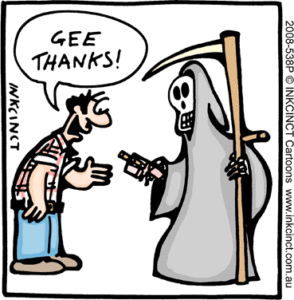 John Janstch of Duct Tape Marketing constantly offers great advice that is as relevant to nonprofits as it is to the small businesses he works with every day. A few months ago, the Claxon crew got to see him in person in Seattle. Fantastic!
John Janstch of Duct Tape Marketing constantly offers great advice that is as relevant to nonprofits as it is to the small businesses he works with every day. A few months ago, the Claxon crew got to see him in person in Seattle. Fantastic!
This post is modified from a recent post of his called “5 Ways to Use Social Media for Things You Are Already Doing.” What person working in a nonprofit doesn’t like the sound of that?!
Thinking that sounded pretty great, I took his key points and made them specific to nonprofits. (My changes are in [brackets].) The terminology may be different, but the advice is the same. And it’s good!
1) Follow up with [prospective donors]
I love using social media tools as a way to follow-up with [prospective donors] you might meet out there in the real world. So you go to an [AFP or NDOA] event and meet someone that has asked you to follow-up. Traditionally, you might send an email a week later or call them up and leave a voice mail. What if instead you found them on LinkedIn, asked to be connected and then shared an information rich article that contained tips about the very thing you chatted about at the [AFP/NDOA] mixer. Do you think that next meeting might get started a little quicker towards your [mission]? I sure do.
2) Stay top of mind with [donors]
Once someone becomes a [donor], it’s easy to ignore them, assuming they will [donate] next time they [want to] or, worse yet, assuming they understand the full depth and breadth of your offerings and will chime in when they have other needs. Staying in front of your [donors] and continuing to educate and [move them up the ladder] is a key ingredient to building marketing momentum and few [nonprofits] do it well. [Because it’s really hard to do everything well with so few resources!]
This is an area where a host of social media tools can excel. A blog is a great place to put out a steady stream of useful information and success stories. Encouraging your [donors] to subscribe and comment can lead to further engagement. Recording video stories from [donors] and uploading them to YouTube to embed on your site can create great marketing content and remind your [donors] why they [donate to] you. Facebook Fan pages can be used as a way to implement a [supporter] community and offer education and networking opportunities online. [For a great example of this, check out The Pride Foundation.]
3) Keep up on your industry
Keeping up with what’s happening in any industry is a task that is essential these days. With unparalleled access to information many [donors] can learn as much or more about the products and solutions offered by a [nonprofit] as those charged with suggesting those products and solutions. You better keep up or you risk becoming irrelevant. Of course I could extend this to keeping up with what your [supporters], competitors, and key industry journalists are doing as well.
Here again, new monitoring services and tools steeped in social media and real time reporting make this an easier task. Subscribing to blogs written by industry leaders, competitors and journalists and viewing new content by way of a tool such as Google Reader allows you to scan the day’s content in one place. Setting up Google Alerts and custom Twitter Searches or checking out paid monitoring services such as Radian6 or Trackur allows you to receive daily email reports on the important mentions of industry terms and people so you are up to the minute in the know. (Of course, once you do this you can teach your [donors] how to [learn more about the mission you both care about] and make yourself even more valuable to them – no matter what [your mission may be].)
4) Provide a better [donor] experience
It’s probably impossible to [do too much donor recognition], too [provide too] much of a great experience, but you can go nuts trying.
Using the new breed of online tools you can plug some of the gaps you might have in [cultivating donors] and, combined with your offline touches, create an experience that no [other organization] can match.
While some might not lump this tool into social media, I certainly think any tool that allows you to collaborate with and serve your [donors] qualifies. Using an online project management tool such as Central Desktop allows you to create an entire [donor] education, orientation, and handbook kind of training experience one time and then roll it out to each new [donor] in a high tech [donor] portal kind of way. This approach can easily set you apart from anyone else in your industry and provide the kind of experience that gets [donors engaged].
5) Network with potential partners
Building a strong network of strategic marketing partners (i.e. another organization that cares about the same cause as you and offers complementary services) is probably the best defense against any kind of economic downturn. One of the surest ways to attract potential partners is to build relationships through networking. Of course you know that, but you might not be viewing this kind of networking as a social media function.
If you identify a potential strategic partner, find out if they have a blog and start reading and commenting. Few things will get you noticed faster than smart, genuine blog comments. Once you establish this relationship it might make sense to offer a guest blog post. If your use a CRM tool (and you should) you’ve probably noticed that most are moving to add social media information to contact records, add your potential partners’ social media information and you will learn what’s important to them pretty quickly.
If you know how to set up a blog already, offer to create a blog of network partners so each of you can write about your area of expertise and create some great local SEO for the group.
Maybe you’re not doing all of these things, but you’re probably doing at least a one or two.
Take John’s advice and you’ll definitely engage your donors more effectively. And who doesn’t want that?!
 Ever wondered whether you should use “nonprofit” or “non-profit”? If you’re in the U.S. or Canada, the answer is: non-profit.
Ever wondered whether you should use “nonprofit” or “non-profit”? If you’re in the U.S. or Canada, the answer is: non-profit.





